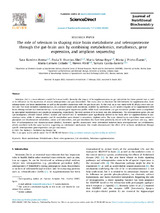The role of selenium in shaping mice brain metabolome and selenoproteome through the gut-brain axis by combining metabolomics, metallomics, gene expression, and amplicon sequencing
Autor
Ramírez-Acosta, Sara
Huertas-Abril, Paula V
Selma-Royo, Marta
Prieto-Álamo, M. José
Collado, María Carmen
Abril, Nieves
García-Barrera, Tamara
Editor
ElsevierFecha
2023Materia
Brain metabolomeBrain selenoproteome
Gut microbiota
Metabolomics
Selenium supplementation
METS:
Mostrar el registro METSPREMIS:
Mostrar el registro PREMISMetadatos
Mostrar el registro completo del ítemResumen
Selenium (Se) is a trace element crucial for human health. Recently, the impact of Se supplementation on gut microbiota has been pointed out as well as its influence on the expression of certain selenoproteins and gut metabolites. This study aims to elucidate the link between Se supplementation, brain selenoproteins and brain metabolome as well as the possible connection with the gut-brain axis. To this end, an in vivo study with 40 BALB/c mice was carried out. The study included conventional (n=20) and mice model with microbiota depleted by antibiotics (n=20) under a regular or Se supplemented diet. Brain selenoproteome was determined by a transcriptomic/gene expression profile, while brain metabolome and gut microbiota profiles were accomplished by untargeted metabolomics and amplicon sequencing, respectively. The total content of Se in brain was also determined. The selenoproteins genes Dio and Gpx isoenzymes, SelenoH, SelenoI, SelenoT, SelenoV, and SelenoW and 31 metabolites were significantly altered in the brain after Se supplementation in conventional mice, while 11 selenoproteins and 26 metabolites were altered in microbiota depleted mice. The main altered brain metabolites were related to glyoxylate and dicarboxylate metabolism, amino acid metabolism, and gut microbiota that have been previously related with the gut-brain axis (e.g., members of Lachnospiraceae and Ruminococcaceae families). Moreover, specific associations were determined between brain selenoproteome and metabolome, which correlated with the same bacteria, suggesting an intertwined mechanism. Our results demonstrated the effect of Se on brain metabolome through specific selenoproteins gene expression and gut microbiota.

